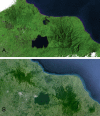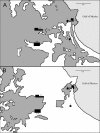Decadal changes and delayed avian species losses due to deforestation in the northern Neotropics
- PMID: 24133637
- PMCID: PMC3796372
- DOI: 10.7717/peerj.179
Decadal changes and delayed avian species losses due to deforestation in the northern Neotropics
Abstract
How avifauna respond to the long-term loss and fragmentation of tropical forests is a critical issue in biodiversity management. We use data from over 30 years to gain insights into such changes in the northernmost Neotropical rainforest in the Sierra de Los Tuxtlas of southern Veracruz, Mexico. This region has been extensively deforested over the past half-century. The Estación de Biología Tropical Los Tuxtlas, of the Universidad Nacional Autónoma de México (UNAM), protects a 640 ha tract of lowland forest. It became relatively isolated from other forested tracts between 1975 and 1985, but it retains a corridor of forest to more extensive forests at higher elevations on Volcán San Martín. Most deforestation in this area occurred during the 1970s and early 1980s. Forest birds were sampled on the station and surrounding areas using mist nets during eight non-breeding seasons from 1973 to 2004 (though in some seasons netting extended into the local breeding season for some species). Our data suggested extirpations or declines in 12 species of birds subject to capture in mist nets. Six of the eight species no longer present were captured in 1992-95, but not in 2003-2004. Presence/absence data from netting and observational data suggested that another four low-density species also disappeared since sampling began. This indicates a substantial time lag between the loss of habitat and the apparent extirpation of these species. Delayed species loss and the heterogeneous nature of the species affected will be important factors in tropical forest management and conservation.
Keywords: Birds; Conservation; Deforestation; Ecology; Extinction; Extirpation; Habitat loss; Species loss.
Figures



Similar articles
-
Elevational Ranges of Montane Birds and Deforestation in the Western Andes of Colombia.PLoS One. 2015 Dec 7;10(12):e0143311. doi: 10.1371/journal.pone.0143311. eCollection 2015. PLoS One. 2015. PMID: 26641477 Free PMC article.
-
Long-term monitoring reveals widespread and severe declines of understory birds in a protected Neotropical forest.Proc Natl Acad Sci U S A. 2022 Apr 19;119(16):e2108731119. doi: 10.1073/pnas.2108731119. Epub 2022 Apr 4. Proc Natl Acad Sci U S A. 2022. PMID: 35377736 Free PMC article.
-
Hydroids (Cnidaria, Hydrozoa) from Mauritanian Coral Mounds.Zootaxa. 2020 Nov 16;4878(3):zootaxa.4878.3.2. doi: 10.11646/zootaxa.4878.3.2. Zootaxa. 2020. PMID: 33311142
-
Direct and cascading effects of landscape structure on tropical forest and non-forest frugivorous birds.Ecol Appl. 2018 Dec;28(8):2024-2032. doi: 10.1002/eap.1791. Epub 2018 Sep 12. Ecol Appl. 2018. PMID: 30277623
-
Thresholds of species loss in Amazonian deforestation frontier landscapes.Conserv Biol. 2015 Apr;29(2):440-51. doi: 10.1111/cobi.12446. Epub 2015 Jan 7. Conserv Biol. 2015. PMID: 25580947
Cited by
-
Enigmatic declines in bird numbers in lowland forest of eastern Ecuador may be a consequence of climate change.PeerJ. 2015 Aug 11;3:e1177. doi: 10.7717/peerj.1177. eCollection 2015. PeerJ. 2015. PMID: 26339554 Free PMC article.
-
DNA barcodes of birds from northern Colombia.Biodivers Data J. 2021 May 21;9:e64842. doi: 10.3897/BDJ.9.e64842. eCollection 2021. Biodivers Data J. 2021. PMID: 34084068 Free PMC article.
References
-
- Andrén H. Effects of habitat fragmentation on birds and mammals in landscapes with different proportions of suitable habitat: a review. Oikos. 1994;71:355–366. doi: 10.2307/3545823. - DOI
-
- Andrle RF. North American migrants in the Sierra de Tuxtla of southern Veracruz, Mexico. The Condor. 1966;68:177–184. doi: 10.2307/1365716. - DOI
-
- Barlow J, Peres CA, Henriques LMP, Stouffer PC, Wunderle JM. The responses of understorey birds to forest fragmentation, logging and wildfires: an Amazonian synthesis. Biological Conservation. 2006;128:182–192. doi: 10.1016/j.biocon.2005.09.028. - DOI
-
- Becker P, Moure JS, Peralta FJA. More about euglossine bees in Amazonian forest fragments. Biotropica. 1991;23:586–591. doi: 10.2307/2388396. - DOI
-
- Bierregaard RO, Lovejoy TE. Birds in Amazonian forest fragments: effects of insularization. In: Oellet H, editor. Acta XIX congressus internationalis ornithologici. Ottawa: University of Ottawa Press; 1988. pp. 1564–1579.
LinkOut - more resources
Full Text Sources
Other Literature Sources
Miscellaneous

